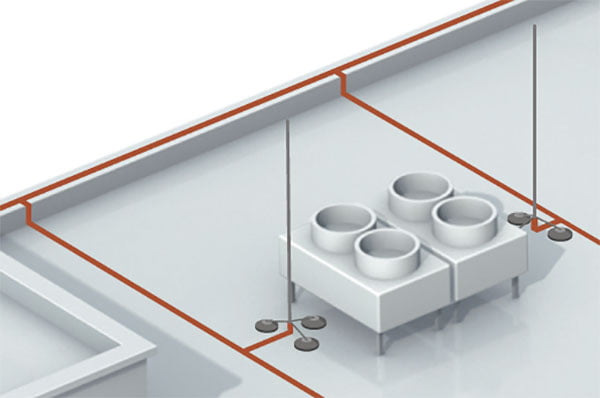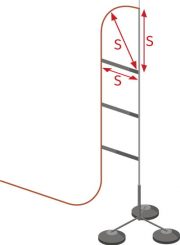Air Termination Systems
Roof Mesh Conductor Systems
Kingsmill offers a choice of conductors and fittings for use in the construction of a roof mesh.
These are shown in the sections – Conductors and Fittings.
Our range includes solid circular, rectangular tape and stranded conductors, as well as PVC coated. Thus giving the designer the flexibility to blend the Lightning Protection network into the building facade.
Conductors are an important element of a Lightning Protection System. They can be used by themselves in a mesh or in combination with Air Terminals.
Conductors are also the main element in both down conductor (the path by which lightning is taken safely to the earth system) and earthing (the path by which the lightning current is discharged to earth).
Given the importance of conductors (and their fittings) to the three elements of an effective lightning protection scheme, we have dedicated two sections to these products: Conductors and Fittings

Conventional Small Air Terminals
Available in both copper and aluminium, Conventional Small Air Terminals offer a quick and easy solution for Air Terminals of 0.5m to 3.0m in height.
They are suitable for use with flat and circular conductors.
Flat parapet, ridge saddle and wall-mounting bases are available.


Lightweight Lightning Mast
The Lightweight Lightning Mast is our premier product, offering height combinations from 5m to 20m. Its conical shape adds considerable strength and thus resistance to deflection/whipping in the wind.
It is easy to fix. In fact, the building itself can become the foundation for the mast, alleviating the need for heavy and unsightly concrete blocks and tripods.
The hinged base design allows easy inspection and maintenance.
The mast can be supplied in different colours and graphics to blend in with building architecture and landscaping designs.
When aesthetics are important – this is the product for you.
Due to its composite material the Lightweight Lightning Mast is non-corrosive. This allows for a longer life than conventional metal masts. It is also an insulator, reducing touch potential problems.
The mast can also be combined with aerial wires to form part of a catenary wire system.


FREE-STANDING AIR TERMINALS
The top of Free-Standing Air Terminals could deflect under some wind conditions. This is due to the nature of their construction and having smaller diameter mast sections.
These terminals require to be weighted down with concrete blocks and tripod structures. This may be problematic in terms of weight loading on some roofs, particularly when retro-fitting.
A reasonable amount of clear roof space is required to accommodate both the separation distance and tripod base.
These terminals are a simple solution to protecting roof mounted plant, when aesthetics are of less importance.


INSULATED LIGHTNING CONDUCTOR
Insulated Lightning Conductor cable is ideal for use where there is insufficient roof space to install Conventional and Free-Standing Lightning Protection Masts/Air Terminals while maintaining the required separation distance from the object being protected.
Insulated Lightning Conductor Air Terminals/ Lightning Protection Masts are constructed from:
- Aluminium interception Air Terminal/Rod 0.5m to 1m
- GRP mast section varying from 2m to 3m for wall fixing installations and 1.5m when used with a stainless steel Mast and Base
- Stainless steel Mast section to give mast height and supporting strength
- Stainless steel Base
When used in conjunction with Kingsmill Insulated Lightning Conductor cable, the Air Terminal can be placed closer to objects that require protection. The cable simulates a separation distance of ≤0.75m in air and ≥1.5m in solid material.
Kingsmill Insulated Lightning Conductor cable is used for maintaining separation distance between the electrically conductive parts of the structure (to be protected) and the Lightning Protection System.


CATENARY WIRE SYSTEMS
Kingsmill can offer Catenary Wire Systems and application designs.
Each system tends to be unique in terms of both material selection and protection area.
Please contact Kingsmill sales support staff with your project requirements.


Isolated Systems
Isolated Systems using Insulated Spacer Bars and Masts
Kingsmill can offer bespoke Isolated Lightning Protection Systems, where the Lightning Protection Conductor Network is installed in such a way that the lightning current does not come into contact with the object/structure being protected.
NOTE: such systems are designed for use with 8mm diameter conductor, due to the ability to bend such material through 360° (all planes) whereas a tape can only be bent through one plane.
Example of an isolated lightning protection system using mast and insulated bars to maintain the separation distance from the object being protected.

